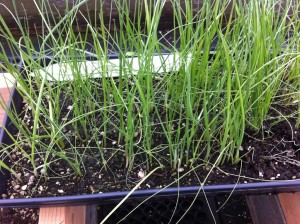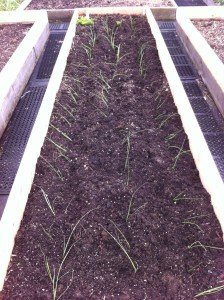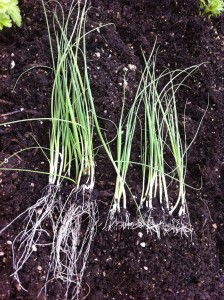And they said unto him, “Speak to us now of leeks,”
And he spake thus:
“What is first together must be drawn apart,
And what is shallow must be made deep.
That which is green should be made white,
And if summer be a time of working, winter will bring feasting.”
And the people looked at one another with amazement and spoke with one voice:
“Verily, o Sage, thou hast spoken truly.”
Source unknown, probably a relative of Kahlil Gibran
Today I transplanted leeks at the Rot, leeks sown on the very first day of the year. Since today is day #98 on my continuously numbered calendar, that means it’s taken 97 days for these leeks to reach transplantable size. I sow my leeks in standard 11×22 inch flats filled with potting soil. In such a flat, I sow four rows of leeks, and when 90 or so days have past, they look like this:

From this point it is an easy matter to prepare them for transplant. If the potting soil is very moist, then it’s just a matter of tugging on the green leaves and the tiny plants will come up roots and all. If the soil is drier, then you might consider taking out a block of plants and soaking the soil until the whole thing loosens up. Either way, you are going to wind up with a bundle of transplantable leek plants. To tame their unruly roots, I often give them a cut, leaving about a half-inch of roots and getting rid of the rest. This will help when you are poking the plants into holes, but first look at what the freshly extracted and the freshly trimmed plants look like:
The bed I planted into at the Noble Rot today had just received two sacks of well-composted chicken manure and a topping of fresh planting compost, so these leeks should be off and running. In this 3 foot wide by thirteen foot long bed I made three furrows about 3″ deep the entire length of the bed. Then every 4″ (or so) I stuck my finger into the bottom of the furrow, creating an even deeper hole for the leek and then just popped one of the trimmed transplants into the hole, lightly covering it after planting.
A newly planted bed of leeks is not exactly a noble sight. In fact it looks rag-tag, with those tottering little babes all askew, almost as if these plants were vulnerable interlopers in an otherwise barren environment. See for yourselves:

But as they grow, they will straighten up and fill in, and eventually there will be more leek than bare space, and the bed will belong to them. As they do grow, I will be filling in more of the furrows with additional compost, so that the leeks blanch or turn white. A leek with a long, white shank (the neck of the leek) is a very desirable thing, indeed, as the whitened part is more delicate than the green parts. The way that is achieved is to bury as much of the shank as possible, depriving it of light and thus whitening it.
This planting is one of three that we will do at the Rot. I’ve got another flat coming on now in my greenhouse, ready for transplant in another 30-40 days, and in May I’ll start my last flat for July transplant. We should have leeks rolling in from today’s transplanting by early July, a second pulse in September, and then the final harvest will be a long-play, stretching all through the winter and possibly far into next spring (at home I am still harvesting leeks I planted last July).
So thus it is that the ancient wisdom holds true, and as the sages have taught about leeks, so it is done at the Rot.



